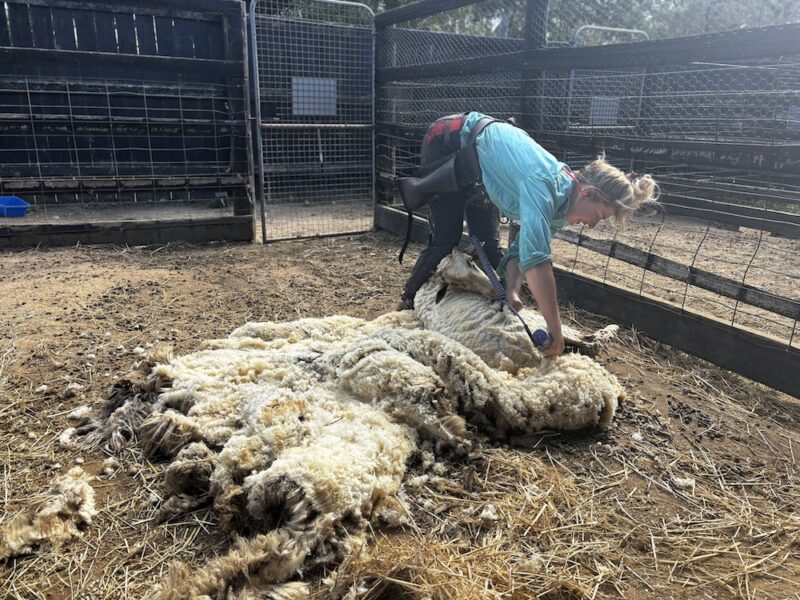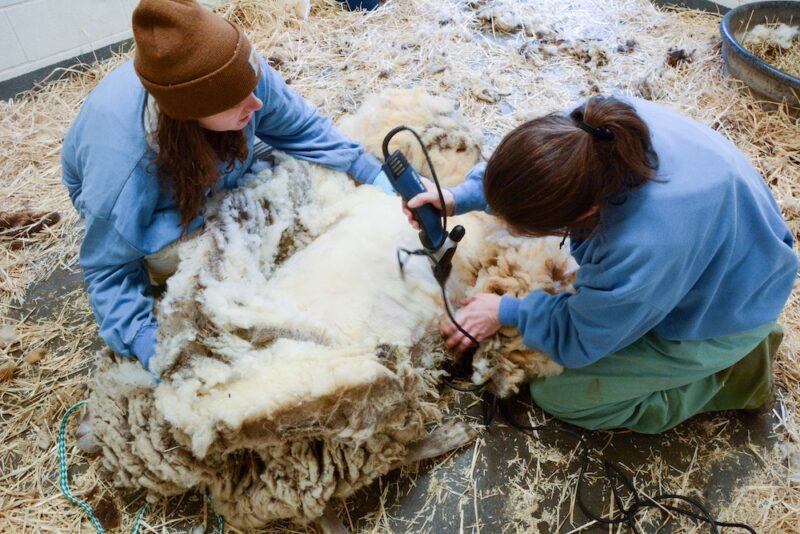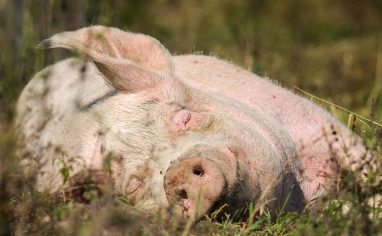
Check Out Our Courses On Basic Sheep And Goat Care!
The following is an excerpt from Basic Sheep And Goat Care Part 2, one of the free course offerings available at our Compassionate Care Classroom. We hope you’ll check out the course, but given the important role shearing plays in the care of woolen residents, we want to ensure this information is easily accessible to anyone looking for it by offering this stand-alone resource. Please note that prior to delving into this topic, the course focuses extensively on gentle handling and restraint which play a crucial role in the shearing process.
If you care for woolen sheep or certain breeds of goats, such as Angoras, you’ll need to incorporate shearing into your care practices because these individuals will not naturally shed their coats. While shearing in agricultural settings is most often based on human desires for sheep or goat fibers, shearing in a compassionate care setting is all about what the individual needs to remain healthy and comfortable. If left in heavy wool coats, woolen residents are at risk of overheating during the warmer months. Additionally, depending on the individual’s breed and the amount of wool they’re carrying, excess wool is also heavy and can make individuals uncomfortable if twigs or other debris becomes lodged in their wool or if it makes it difficult to reach an itchy spot! An individual’s wool can even become matted (or felted) over time, which can be uncomfortable for the individual and can make the shearing process more difficult.
While certain individuals may require something different, in general, sheep and goats who do not shed their coats (and this includes individuals who may be a mix of hair and wool breeds) should be shorn annually. Shearing should be scheduled with the weather in mind – you want to have residents shorn before temperatures start heating up too much, but you also want to avoid doing so when the weather is still cold. It can be tricky to find that sweet spot, and you might be surprised by the temperatures at which your woolen sheep residents start showing signs of discomfort while in full wool. What feels balmy to you might feel downright hot to them when they’re still in their winter coats! However, goats tend to be more sensitive to the cold, so waiting until temperatures are consistently warm may be wise. If temperatures take a dip after residents are shorn, or if you notice that certain individuals appear cold, be prepared to fit them with an appropriate coat following the guidance outlined in Part One of this course.*
*Looking For More On Coats?
In addition to being discussed in Basic Sheep And Goat Care Part 1, the use of coats is discussed in the “Cold Weather Considerations” sections of Creating A Good Home For Sheep and Creating A Good Home For Goats.
When it comes to shearing, you have two options: hire a shearer or shear residents yourself, and we’ll talk more about each. Be aware that after shearing, some residents may temporarily treat each other differently, so be sure to observe them closely to make sure there are no altercations that require intervention.
Option #1: Hire A Shearer

As with any service provider, you’ll need to do your due diligence in terms of finding someone who is both qualified and a good match for your needs. However, be aware that finding a shearer can be tricky depending on where you are located. It’s also important to understand that shearers are often booked months in advance, so you need to plan accordingly! When considering if a particular shearer is right for your sanctuary, be sure to consider their experience and training, the setup they use, whether or not they practice good biosecurity, and if they seem receptive to working with clients who may be a bit different than what they’re used to.
Just as you may need to explain to prospective veterinarians the type of care you are seeking for your residents, you will likely need to have a similar conversation with prospective shearers. Because shearers are likely accustomed to working with clients who are focused on efficiency, speed, and fiber quality, explaining to them that your focus is resident safety and comfort can go a long way. Many shearers charge per sheep/goat (sometimes in addition to setup and travel fees), so in order to encourage shearers to (reasonably) take their time, you may want to have a chat about paying per hour instead. While you certainly don’t want shearers to rush, which could result in rough handling of residents and accidental injury, you also don’t want the process to take forever. Even under the best of circumstances, the shearing process probably won’t be your residents’ favorite thing, so finding a pace that allows shearers to be careful while still being mindful of how long residents must be restrained is key.
Also, be aware that sanctuary residents may be a bit different than the individuals shearers are accustomed to working with. Particularly if they’ve never worked with a sanctuary before, be sure to mention the size of your residents (which may be quite a bit larger than they’re used to) and whether or not any of them have horns and/or full tails, as this may impact what they charge. Also, be aware that some shearers will not work with CL-positive herds or flocks.
When you schedule an appointment with a new shearer, be sure to ask them what they need so that you can be prepared. Depending on their setup, they might need access to a pen that has had all bedding removed and that has an outlet nearby. They may also need to have sanctuary personnel on hand to help with moving and restraining the residents, as well as cleaning up between individuals. (Side note: even if a shearer brings assistants to help move and restrain residents, we still recommend having someone on your caregiving team present for shearing. There are many reasons for this, including being present to make note of any findings during shearing, addressing any accidental cuts, and, if necessary, reminding the shearing team how you expect residents to be handled.)
Most shearers will request that residents be dry for shearing, so you may need to close residents in a day or two before shearing if there is rain in the forecast. Some shearers will be quite upset if residents are wet when they arrive and may refuse to shear wet individuals. Rescheduling, in general, can be tricky, so it’s best to just prepare in advance and keep residents dry. On the day of the appointment, make sure everything is ready to go before the shearer’s scheduled arrival. Even if you are paying by the hour, they likely won’t appreciate having to wait while your team gets things set up. Be sure to have residents closed into a space that makes it easier to move and restrain them. Even the most conscientious of shearers may accidentally nick a resident, so it’s also a good idea to have supplies on hand to clean and treat small wounds. If you want to perform certain healthcare tasks during shearing, be sure to clear this with them in advance.
Option #2: Learn To Shear Residents Yourself

Proper Training Is Key!
The purpose of the following section is not to teach you how to shear but, instead, to offer suggestions for how you can gain the skills needed to do so safely.
Some sanctuaries prefer to shear residents themselves, and others find they have to out of necessity. It can be particularly challenging to find a shearer who is willing to come out to shear just a few individuals, so folks with smaller resident populations may have a trickier time. As mentioned previously, if you have CL-positive individuals, this can also make finding a shearer more challenging. Even if you are able to find a shearer to shear your residents, there may be certain residents whom you’d rather have shorn by sanctuary personnel – this may include elderly and disabled residents. Whether you are shearing select individuals or are taking on the shearing of all residents, you’ll need to learn how to do so, and you’ll need to make sure you have the right tools.
If you’ve observed a professional shearing your residents, you may feel that you understand the process well enough to attempt a variation of it on your own. If you haven’t, you may want to connect with a sanctuary that shears their own residents (or see if you can observe at a sanctuary while a professional shearer shears their residents) so that you can get an idea of the process. While there are online courses for folks who want to learn how to shear, sanctuary caregivers may find that they prefer different restraint methods than those typically used by professional shearers. Since farmed animal sanctuariesAnimal sanctuaries that primarily care for rescued animals that were farmed by humans. are not focused on things like efficiency or the wool coming off in one piece, they can adjust their technique to accommodate the needs of each individual. Be aware that this may result in the shearing process taking more time, so you’ll need to consider how that will impact them. Some residents may allow you to shear them with minimal restraint while they are comfortably lying down, and others may do best restrained in a standing position.
Before attempting to shear your residents, make sure you have the proper tools. While professionals use a more elaborate setup, electric sheep clippers are typically a good option for caregivers. Be aware that electric clippers designed for “petAn animal who spends regular time with humans in their home and life for companionship or human pleasure. Typically a small subset of animal species are considered to be pets by the general public.” hair may work fine to remove a very small patch of wool but are not designed for wool and are not ideal for shearing. Instead, opt for a device designed for wool removal. Be sure to follow the manufacturer’s instructions regarding setup, care, and maintenance of your electric clippers to ensure they work properly (and continue to do so despite ongoing use).
Wondering What To Do With All That Wool?
To learn more about some of the ways to dispose of your residents’ wool, check out our resource here!
SOURCES:
10 Points To Consider When Hiring A Shearer | Shroeder Shearing
Shearing | Sheep 201 (Non-Compassionate Source)
Sheep And Goat Medicine, Second Edition (Non-Compassionate Source)
Non-Compassionate Source?
If a source includes the (Non-Compassionate Source) tag, it means that we do not endorse that particular source’s views about animals, even if some of their insights are valuable from a care perspective. See a more detailed explanation here.








